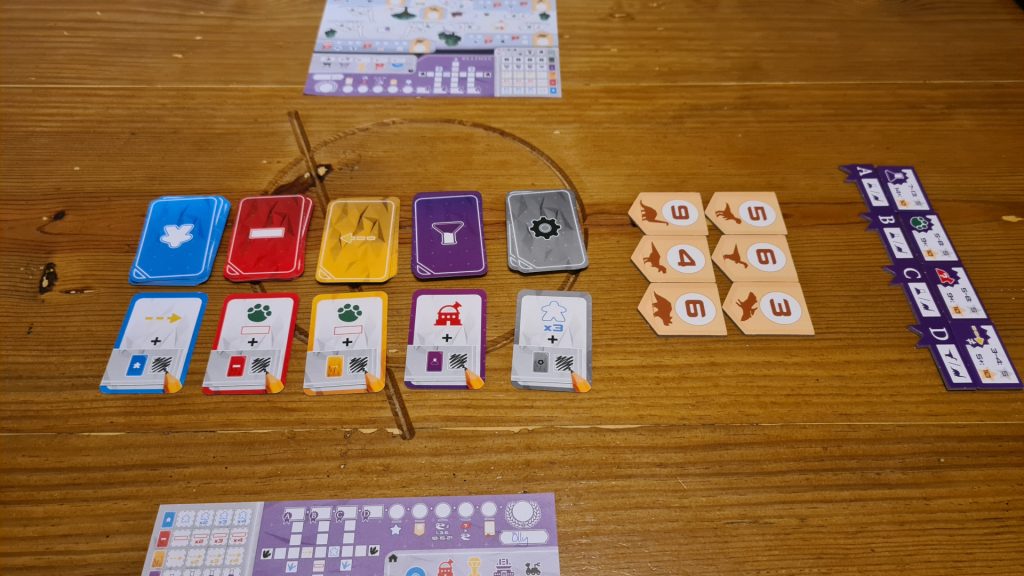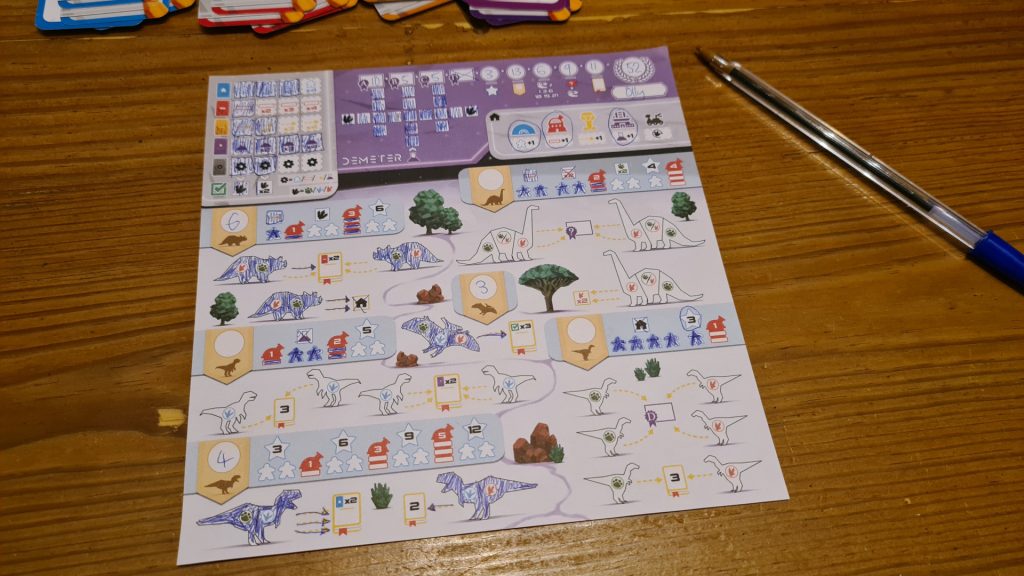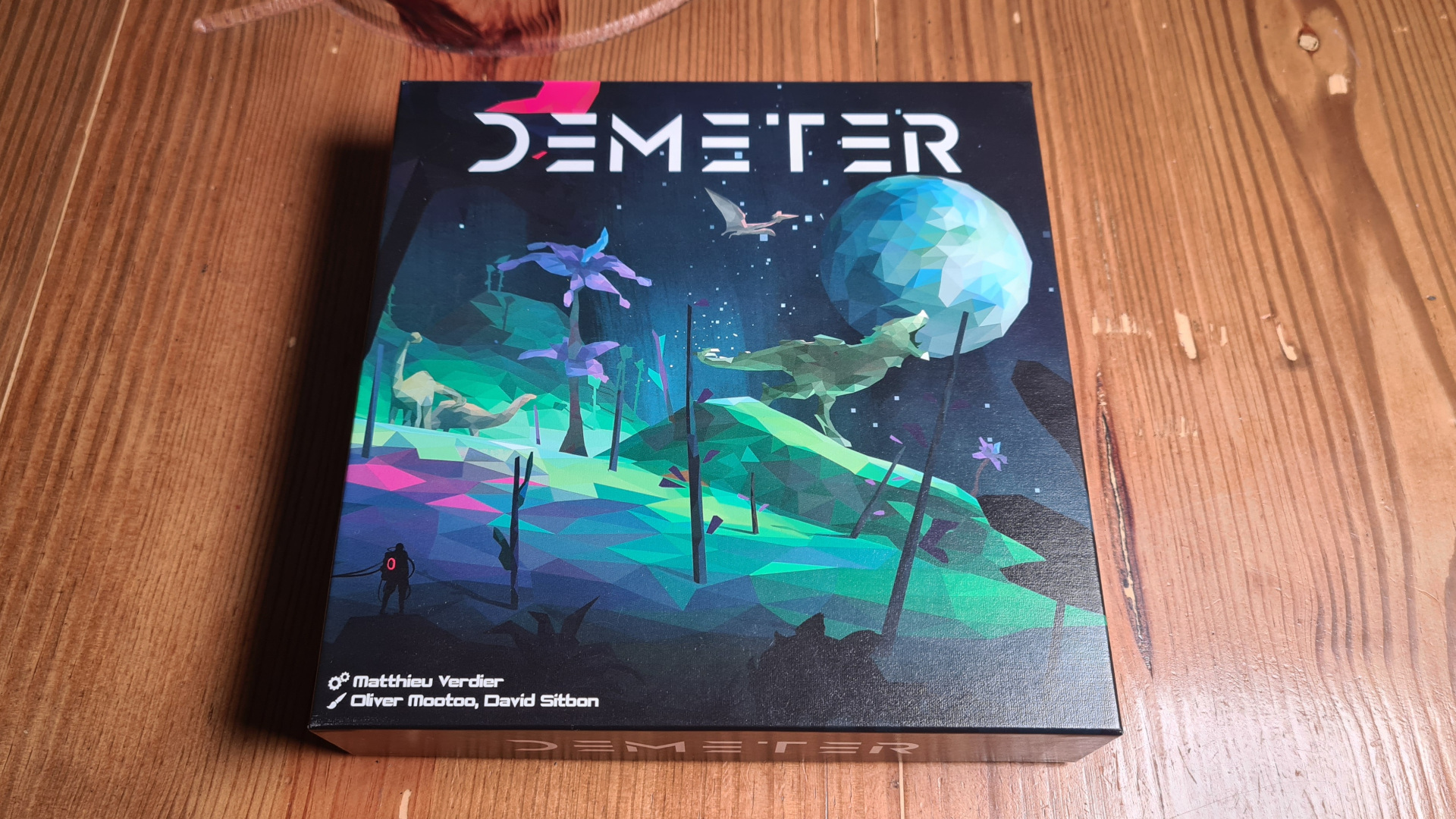Demeter is a flip and write board game, where players discover and study the dinosaurs of Demeter 1. Published by Sorry We Are French and designed by Matthieu Verdier, Demeter sees 1 – 100 players land on the first moon of Ganymede, to find the presence of dinosaurs. Roaming the moon are Triceratops and Raptors, ready to be observed – with games lasting around 20 – 30 minutes. However, will you want to discover all of the dinos? Let’s find out!
Setup is an easy and quick process. Each player takes a scoresheet from the pad and finds a pen. Then, each coloured deck is shuffled separately (with 3 cards removed), the recto-verso species tokens are all placed gold side up in the middle of the table and 4 goal tokens are randomly selected (placed along A – D sections of the scoring tile). There is no starting player as each round is performed simultaneously by all players, so the game is ready to begin.
Each round the top card from each of the five coloured decks is flipped. The players around the table then each choose to use one. The card is not taken and players are free to choose the same card as other players. However, a player may only choose a card of each colour a maximum of 4 times throughout the game. Each card features an action and the colour of the card indicates a bonus – with these bonuses often increasing the more a specific colour is chosen.
The ordering is important, with the action on the card performed first, followed by the bonus action and any triggered bonuses. Actions range from recruiting scientists through to discovering dinosaurs, all slowly getting players towards scoring points. When one of the 3 coloured dinosaur footprints (or the wild symbol) are used the player can shade in a section of a dinosaur of matching footprint. When an entire dinosaur is shaded in it becomes discovered. When all dinosaurs of the same species are fully discovered the player scores the points on the species bonus tile, if they are first they score the golden side before flipping it to the lesser silver side.

When a dinosaur is discovered the player could take the study lines action to study the dinosaur. Some dinosaurs have numerous study lines pointing towards a bonus; which could be straight victory points, a way to score points such as allowing objective tile D to be scored or the option to draw a wild dinosaur footprint.
Each region has spaces for scientists and observation posts, regardless of discovered dinosaurs. While a few scientists can be shaded in, via the recruit action, at the start of the game most are blocked behind unconstructed observation posts. Taking the observation action will allow the player to shade in a block of the observation post and once finished it enables the next section of scientists to be recruited. At the end of the game each region will then score points based on the number of fully discovered dinosaurs multiplied by the highest valued completed observation post. Some groups of scientists trigger bonuses like free footprints or study lines, while others will award the player points.
The final main section is research. Taking this action allows the player to shade in an adjacent research space. Advancing up and across the research track, not only unlocks bonus actions every other space, getting to the top of the track unlocks scoring objective tiles A – C. Each of the main actions can be upgraded by taking their associated buildings, when they come up on the cards. For example with the scientist building built, every time a player recruits at least one scientist they get a bonus one. Then there’s the rover which allows players to replace a footprint with a wild one every turn.
Played over 12 rounds, each sees players choosing a card and trying to string bonus actions together to colour in as many dinosaur parts, scientists, observations posts and more. There might be five cards to choose from but with all of the ways they can be used and the bonuses triggered there is a fair amount of meat to each and every selection. With a total of 9 different ways to score, each turn will be an opportunity to get more points. Mission points are the aim of the game with the winner whomever has the most points, with tied victories shared.
There’s no getting away from the daunting feeling of that first look at a scoresheet; full to the brim with spaces to colour in and symbols galore. Taking an action and then triggering bonus actions does little to ease this worry when going over the rules. Soon though the wide number of symbols and iconography stop being daunting and become easily recognisable. This makes the turns simply about working out what works for you and not deciphering what you can do.

Demeter is somewhat of a point salad style game, with players able to get points in up to 9 different ways. They drag players in different and often opposite directions but there are still lots of ways to score. For instance, the fully discovered species and unique species discovered objectives are completely different in focus, but both score players points at the end of the game. The trick, if my low scores are to reveal anything, is to not aim down the middle to do both and instead commit to one of this pair to score well – and this logic applies across a number of the other scoring conditions too.
Most roll and writes, or flip and writes, allow for the odd combo turn. Occasionally, a player might tick a box or shade something in and trigger a bonus action. In Demeter players always get at least one bonus from the colour of card they choose. As the game progresses a lot of additional bonuses are also triggered for groups of scientists etc. A basic turn can therefore involve performing 3+ actions. For those willing to take turns quickly this isn’t a problem. Those that suffer from analysis paralysis, this number of knock on effects could slow your gameplay down to a snail’s pace.
One aspect that can massively change the way a game plays out is how early the cards with buildings come out. If they come out in the first couple of rounds these are almost a must to take. The sheer number of bonuses that can have been gained by the end of play really add up and make big individual turns even bigger and better. Of course this only adds to the aforementioned comboing opportunities and AP potential.
The theming of dinosaurs comes though quickly from the variety of species, from a Pterodactyl to the T-Rex, on the scoresheets. The space mission side of things, which stems from Sorry We Are French’s Ganymede, alas is pretty much lost when playing – though Demeter isn’t any worse off for this. Many of Demeter’s actions are interwoven and also offer bonus actions, with the choice of one card per round often escalating into doing much more than just one thing each turn. Demeter is more involved than most roll and writes. It’s not afraid of having a lot of combos triggering on each and every turn. This means it might not be the game you bring out with the family but gamers will certainly enjoy it.
(Editor’s Note: Demeter was provided to us by Hachette Boardgames UK for the review. The game is currently available from local board game stores! Find your local store here.)

